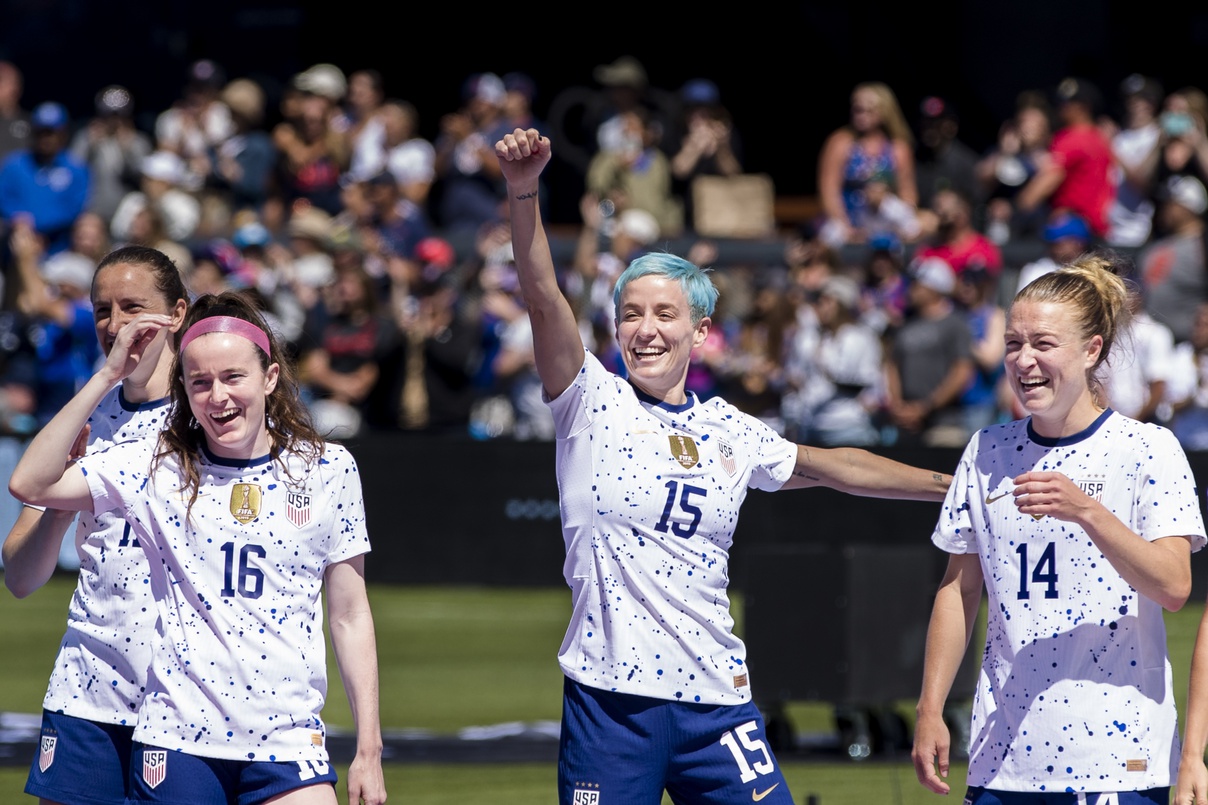Ahead of the FIFA Women’s World Cup in Australia and New Zealand, which starts this Thursday, Martin Keady, our resident football historian, assesses whether the USA can win a third World Cup in a row and thus become the most successful international team of either gender.
In 2019, when the United States Women’s National Team (USWNT) won their second Women’s World Cup in succession, Martin Keady wrote that they had joined the most exclusive club in football: the teams of either gender who had retained their world title. Now, four years later, the USWNT have a chance to achieve something that no other international team, male or female, has ever done, namely winning three World Cups in a row. Can they do it?
Can the USWNT Become The GOATs in Women’s Football?
World Cup Ready 🇺🇸 pic.twitter.com/IDxe6VgDo9
— U.S. Women's National Soccer Team (@USWNT) July 18, 2023
Time Heals All Wounds – And Wounds All Heels
As Novak Djokovic has just discovered at Wimbledon, where he lost to the brilliant young Spaniard Carlos Alcaraz, even the greatest sportspeople or sports teams eventually lose. So, the biggest obstacle facing the USWNT as they attempt to become the first team to win three World Cups in a row is almost certainly their own increasing age, which inevitably brings with it increasing frailty.
That is evident in the team’s talisman, Megan Rapinoe, who recently announced that she would be retiring at the end of the National Women’s Soccer League (NWSL) this year. Rapinoe is now 38 and has been a mainstay of the USWNT throughout the last dozen or so years, during which time she has won an Olympic Gold in London in 2012 to go alongside her two world titles. As a result of her extraordinary on-field success and equally extraordinary off-field activism (a proudly out gay woman, Rapinoe has been one of the highest-profile campaigners for both LGBTQI+ rights and equality of pay for both men’s and women’s football teams), she has become probably the most famous female footballer ever.
READ MORE: USA Join The Pantheon of Double World Champions
Naturally, Rapinoe sees this year’s tournament as the perfect opportunity to bow out from international football. However, like other key members of the USWNT team, notably central striker Alex Morgan, who is now 34 and with whom Rapinoe has formed arguably the deadliest front-line in women’s football ever, she is obviously now four years older than in 2019 and approaching the end of her career. Consequently, it is at least questionable whether she will be as effective as she has been before.
And Three Deadly Competitors
In addition to their own possible frailties, the USWNT will also face arguably the toughest collection of competitors that they have faced at a World Cup, with their three biggest challengers being fellow Anglophone countries: England; co-hosts Australia; and neighbours Canada.
England will obviously be immeasurably boosted by having won the Euros last summer; indeed, winning their first major tournament of any kind was arguably harder than winning the World Cup would be. They are considerably weakened by the loss through injury of two key parts of their spine, namely the Arsenal duo of centre-back (and captain) Leah Williamson and forward (and star of the Euros) Beth Mead. However, there is new Arsenal signing Alessia Russo, who will surely replace Mead as a starter this summer after starring from the substitutes bench at the Euros. She could emerge as a Golden Boot contender and thus become the inspiration for her team to make a long run.
READ MORE: After Achieving The Impossible, a World Cup Win Would Be Easy For England’s Women
Similarly, Chelsea’s Sam Kerr will spearhead tournament co-hosts Australia. New Zealand, the other host nation, are unlikely to challenge for the title, but the Matildas will almost certainly be serious contenders, especially on home soil. They reached the semi-final of the last Olympics in Tokyo, losing to eventual runners-up Sweden, and will fancy their chances of at least going one better and reaching the final this summer, especially if they enjoy the kind of thunderous vocal support that is the norm for Australian international sports teams, particularly when they are playing in Australia.
The third and final major contender for this year’s Women’s World Cup, besides the USWNT themselves, is surely Canada, the reigning Olympic Champions. Like the USA, they have long been one of the powerhouses of women’s international football, which is a testament to the equalities legislation enacted in the early 1970s that gave North American girls equal access to the same opportunities to play football as boys, allowing both the USA and Canada to outstrip traditional male footballing superpowers, such as those of Europe and South America, in female football. Buoyed by their Olympic title, Canada will be determined to try and win their first World Cup.
Odds Are Against A Hat-trick, But That Will Only Inspire The U.S. More
As a result of their own advanced age and the strength of the teams lined up against them, the odds will be against the USA making it a hat-trick of world titles this summer; after all, no other team before them has ever achieved what might be called “The Magic Hat-Trick”. However, like most female footballers, players such as Megan Rapinoe and Alex Morgan have always faced almost overwhelming odds to succeed throughout their career and consequently they will regard winning a third World Cup in a row as just another obstacle to overcome. And if they do succeed, they will have done what the three previous double World Champions failed to do.
How Previous Two-Time World Cup Winners Failed Third Time Around
Italy Men (1934 and 1938): Vittorio Pozzo’s Azzurri were the first team to retain the World Cup, following up their 1934 triumph on home soil with victory in nearby France four years later (which was the last time that the World Cup did not rotate between continents). Because of World War Two, they never got a chance to make it a hat-trick of World Cup triumphs. Indeed, it would be nearly half a century before Italy won their third World Cup when six-goal striker Paolo Rossi almost single-handedly fired them to a World Cup triumph in Spain in 1982.
Brazil Men (1958 and 1962): The closest equivalent to the current USWNT in men’s football is probably the great Brazilian men’s side of 1958 and 1962, who won the World Cup first in Sweden (with a 17-year-old Pelé starring) and then in Chile (when the injured Pelé was replaced as the team’s talisman by the almost equally brilliant winger Garrincha). They were unable to make it a hat-trick of titles in England in 1966 when Pelé was effectively kicked out of the tournament and they duly exited in the first round. However, they achieved the next best thing by winning three World Cups out of four, when the greatest Brazilian side ever and arguably the greatest international side ever (at least on the men’s side) won again in Mexico in 1970.
Germany Women (2003 and 2007): The first female footballers to win two World Cups in a row were not the USWNT but Germany’s women, in 2003 and 2007. That truly great team, which also won multiple European titles, was led and symbolised by arguably the greatest female footballer ever, Birgit Prinz, who was Germany’s female equivalent of the great Gerd Muller, i.e. a prodigious scorer at the club and international level. However, perhaps like Megan Rapinoe in 2023, Prinz was probably past her best in 2011 and so, even though they were playing on home soil, Germany limply lost in the quarterfinals of that World Cup to eventual winners Japan.
Photo Credit: John Hefti-USA Today Sports, of a USWNT Headshot, on July 9, 2023.





